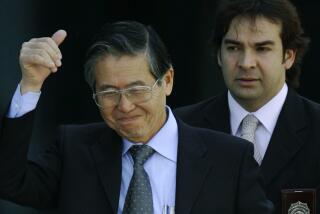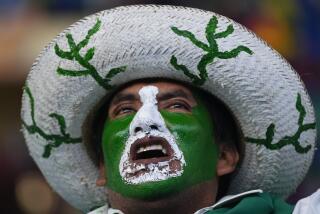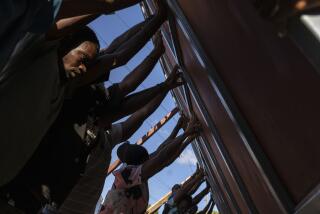Peru’s Poor See Lessons in Standoff
- Share via
LIMA, Peru — It is not a happy new year in the street market in the Lince neighborhood, one of the bustling and motley outposts of the vast informal economy that employs half of all economically active Peruvians.
Vendor Carmen Iparaguirre earned a university degree in hotel and tourism management five years ago. But she could not find work. So she sells women’s hats, underwear and blouses in a sidewalk stall, making about $130 a month. She says she looks ahead to 1997 with fear.
“Imagine how we rang in the new year, with a terrorist attack,” the soft-spoken vendor said. “What else are the terrorists capable of doing? People overseas are watching this. . . . I’m worried they won’t want to invest, to travel here.”
The hostage standoff in the Japanese ambassador’s residence in the capital has reverberated among Lima’s humble street capitalists just as it has in corporate boardrooms and government palaces.
The vendors of Lince condemn the terrorists’ methods but say that the attack by members of the Tupac Amaru Revolutionary Movement has called attention to economic injustices.
“The economy has gotten better for some, but not for the poor,” said Victor Balzan, 39, who sells radios, batteries and other electronic goods with the help of his 12-year-old son. “The economy of the people is different from that of the elite, the middle class.”
The numbers tell a more complex story.
In 1990, when President Alberto Fujimori took office, the always stratified society was disintegrating under assaults by inflation, poverty and terrorist violence.
Fujimori went after terrorism with a vengeance and set in place an economic plan that slashed inflation, cranked the country’s annual growth rate to a world-leading 12.9% in 1994 and reduced the share of Peruvians in poverty from 53% to 46%. Other indicators also reflected growth, such as a 23% increase in tourism in 1995.
But the government was forced to tighten monetary policy in 1995; the boom slowed. Fujimori argues that the recovery is on course and that he has made important inroads against the centuries-old blight of poverty.
Still, the president “has to structure himself for the second generation of reforms,” said economist Hernando de Soto, a former Fujimori advisor and author of the book “The Other Path.”
That title refers to the acumen of Peru’s street entrepreneurs, whom De Soto sees as the answer to the terrorist violence of the Tupac Amaru and the Sendero Luminoso, or Shining Path. He says the way to transform Peruvian society is to unleash the potential of the poor by giving them more access to markets and credits.
Some of De Soto’s proposals are controversial, but his celebration of the informal economy is borne out by the thoughtfulness and tenacity of the vendors in Lince.
The market is a dense labyrinth of stands selling every imaginable product, a place where the informal economy has been formalized to the point that Balzan has operated from the same spot on the sidewalk for 10 years.
Balzan and the others are frustrated with the government but dubious about the Tupac Amaru’s claims to speak on behalf of the downtrodden.
And Balzan approves of Fujimori’s stern response to the terrorists.
“It’s good that he doesn’t let them twist his arm,” he said.
As the guerrillas and the government fight their war of nerves, the vendors of Lince remain where they have always been: in the middle, waiting for someone to lend them a hand but ready to make it on their own.
“You solve nothing with violence,” Iparaguirre said. “What we need are jobs. Even people with education are without work. And those are the kind of people who can end up becoming terrorists.”
More to Read
Sign up for Essential California
The most important California stories and recommendations in your inbox every morning.
You may occasionally receive promotional content from the Los Angeles Times.










